How to Spray Paint Vinyl – Detailed Guide for Perfect Results
This post may contain affiliate links. We may earn a small commission from purchases made through them, at no additional cost to you.
Vinyl can be tricky to paint because it isn’t porous. This means that if you want to paint vinyl you will need to choose a suitable paint. Using vinyl spray paints is a good choice because they are affordable, easy to use, compact, and don’t require extensive cleanup. Spray paint is an easy way to revamp or reinforce vinyl but if you choose a brand that is not suitable for vinyl it will peel right off or make a huge mess. In this article we cover where you might encounter vinyl, why you might want to paint your vinyl, what you need to know when choosing a spray paint to use on vinyl, what is the best spray paint for vinyl as well as how to use spray paint on vinyl.
Table of Contents
- 1 What Is Vinyl and How Is It Used?
- 2 Different Types of Spray Paint for Vinyl
- 3 How to Spray Paint Vinyl
- 4 How to Use Vinyl Spray Paint Safely
- 5 What to Consider When Buying Spray Paint for Vinyl
- 6 How Do I Remove Paint From Vinyl?
- 7 Frequently Asked Questions
What Is Vinyl and How Is It Used?
Vinyl is also known as PVC and is a widely used kind of plastic. Vinyl is used to make siding, flooring, fencing, and guttering as well as dashboards, armrests, and upholstery. This commonly used material is cheap and easy to manufacture making it extremely versatile in many industries.
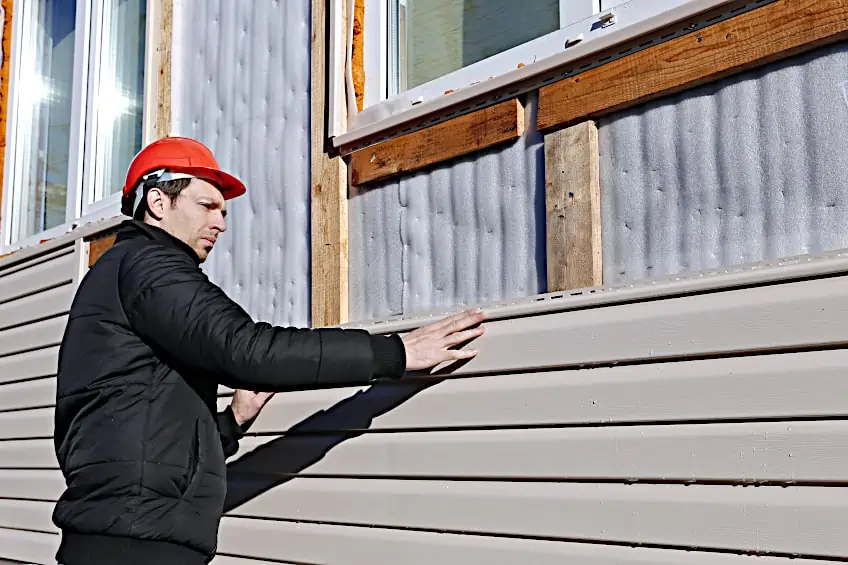
What Is Vinyl Paint Used For?
Vinyl paint is used to refurbish tired-looking vinyl or to change its color. Old vinyl can look faded and worn, which can look unappealing in cars, on furniture, or on siding and fencing. A fresh coat of paint can go a long way and save you money since you will not have to replace or reupholster your belongings. Vinyl spray can make the surface of your vinyl waterproof and more resistant to damage. In this way, paint for vinyl adds strength and durability to vinyl surfaces.

Vinyl spray paint can also help to cover up imperfections on vinyl surfaces. This can mean covering a stain on a couch, or a complete respray of the faded siding on your home’s exterior. If the surface shows significant signs of damage, then a can of vinyl spray paint will not be enough on its own. Damaged surfaces will need proper treatment before a vinyl spray paint can be applied.

Different Types of Spray Paint for Vinyl
When choosing a spray paint for vinyl you will discover a few different kinds available. The choice will be between enamel, acrylic, latex, or chalk spray paint. The best spray paint for vinyl is either acrylic or latex spray paint. These paints have very good adhesion and flexibility which means they don’t crack or peel on the surface of vinyl once dried. Enamel and chalk spray paints can also be used if they have been graded for use on vinyl but they may require more preparation on the surface to work as effectively.
| Consistency | Water and Heat Resistance | Flexibility & Adhesion | |
| Enamel | Thick and pasty | Water-resistant | Medium |
| Acrylic | Thick and mildly pasty | Water-resistant | High |
| Latex | Medium-thick and pasty | Water- and heat-resistant | High |
| Chalk | Thin and viscous | Water- and heat-resistant | Medium-low |
How to Spray Paint Vinyl
Now that you know how to choose the best spray paint for plastic and you have an idea of what vinyl surfaces you can paint, you probably want to get started. You can easily spray a vinyl chair, vinyl siding on your house, or anything else that you think of. Our step-by-step tutorial below is not specific to any particular vinyl object and covers a broad range of possibilities.
Materials Needed to Paint Vinyl
- A tarp or old newspapers
- Vinyl surface of choice
- Vinyl Spray paint
- A rag or cloth
- Fine-grit sandpaper
- A mild detergent or grease cutter (depending on how dirty the surface is)
- A respirator and rubber gloves (optional)
- Masking tape (optional)
- Spray paint primer (optional)
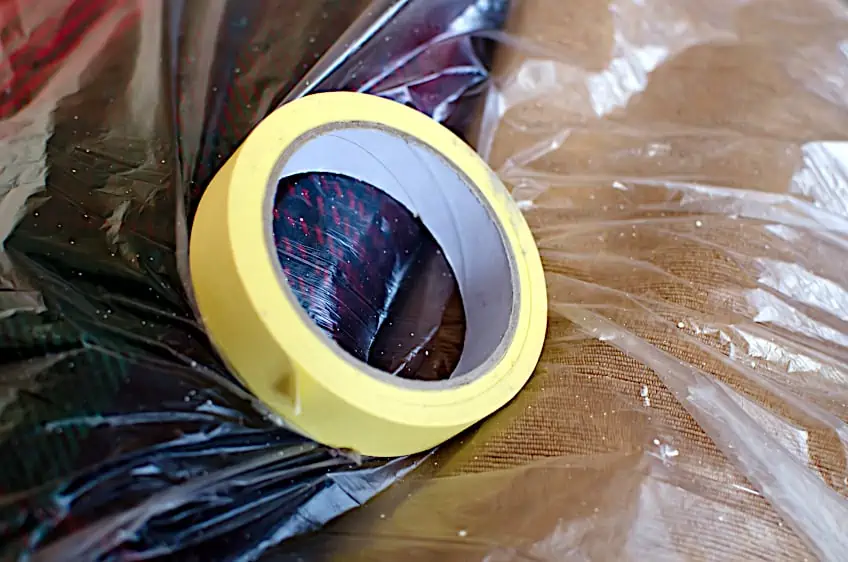
How to Spray Paint Vinyl: A Step-by-Step Tutorial
Spray painting vinyl is fairly straightforward but you will want to be careful so as to avoid having any unnecessary cleanup once your piece is complete. Paint can be tricky to remove from vinyl surfaces so it is best to try to avoid making any glaring mistakes. If you follow our advice, it should be a fun and easy process.
Prepare Your Work Area
Lay down tarp or old newspapers outdoors or in a well-ventilated area. If you choose to work outdoors make sure that the weather is suitable. A day that is too cold, too sunny, or too windy can cause issues when trying to use spray paint. Humidity and rain can be an issue too as they could rinse away your paint, stop your paint from drying or make it impossible to work outdoors. Make sure to work in a season that has optimal weather conditions or check the weather report before you choose a day to get started. Choose to work on a day that has a mild temperature and low humidity for the best results. Don’t try painting in the rain.

If you are working indoors make sure to have lots of windows open and wear a respirator. Proper airflow is important when working with spray paint. The fumes can be bad for you and those around you. If you have a garage, it is the ideal place to work. Make sure that pets and children are kept away from this work area while you are busy.

Clean the Vinyl
Wipe down and clean the surface of the vinyl. Cleaning the vinyl properly ensures better adhesion and prolongs the lifespan of your spray paint application. It is essential to properly remove dirt and grease from your vinyl before painting. To clean your vinyl, start by dusting off any large pieces of dirt from the vinyl surface and wiping the area down with a damp cloth.

Next, you can wash down the area using a soft sponge or soft-bristled scrubbing brush and mild detergent mixed in water. If your area is very greasy or oily you can instead use a degreaser to clean the area. Try to avoid using iron wool or coarse scrubbers as they can scratch and damage the surface of your vinyl. Make sure that you rinse the surface properly then allow it to dry thoroughly before continuing to the next step.

If you are working on something like an exterior wall or fences rather than a piece of furniture, or a car interior, then you can even use a pressure washer with your soapy solution to clean your surface for painting. Just put the soapy solution in your pressure cleaner’s reservoir, point it at the wall or fence, and start cleaning. Make sure that you use the correct setting on your pressure washer depending on the fragility of the surface you wash. Avoid using a degreaser in your pressure washer until you properly read the manufacturer’s instructions on both products.
Prepare the Vinyl
Prepare your surface by lightly sanding the surface with fine-grit sandpaper (optional). This will help the paint adhere to the surface better. Once you sand the area you must make sure to properly dust it before continuing.
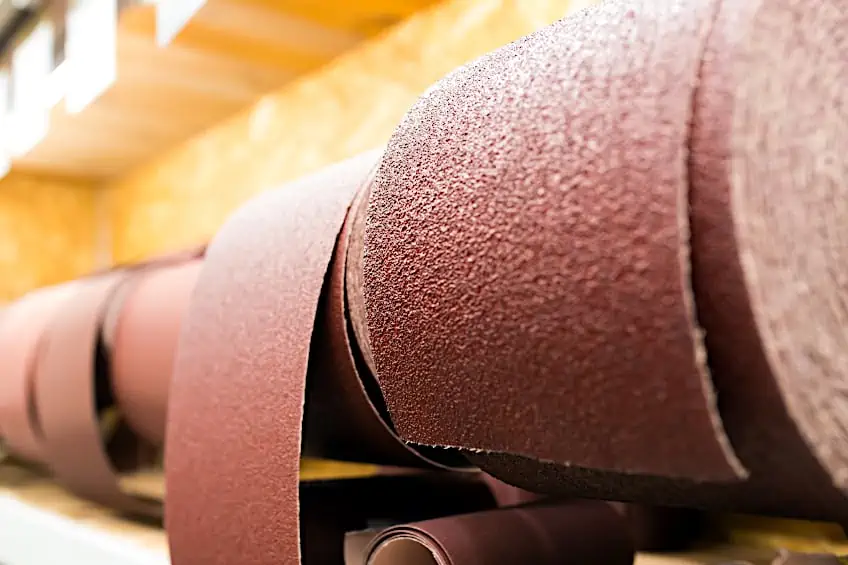
Use your masking tape to tape up areas that you don’t want to spray paint over. Make sure to apply the tape properly to the surface and not leave any gaps. Double-check to make sure that no corners of the tape are loose and that the tape has adhered properly to the surface of the vinyl.
Apply Primer to the Vinyl (Optional)
Apply primer to the surface of your vinyl in short, light, and even bursts. Primer is important for any surface that is receiving paint, but if the paint is of good quality and suitable for the material then it isn’t absolutely necessary. If you are beginning to spray your surface at this stage then make sure you have your gloves and respirator on. This is especially important if you are working indoors. While it isn’t necessary, we strongly advise that you take these proper precautions while working with spray paint and spray paint primer.

Start Spray Painting Your Vinyl
Start spraying your vinyl with paint, in short, even bursts. This helps prevent dripping or blotches on your surface. You will be doing multiple thin coats rather than one thick coat. When you are spraying, aim the nozzle of your spray can towards the air or tarp at the outer edge of your vinyl object or surface and then move back inwards. This can prevent blotches by stopping the initial burst from pooling on your surface. If you are inexperienced with spray cans then we suggest practicing this method on a piece of cardboard before starting on your object.
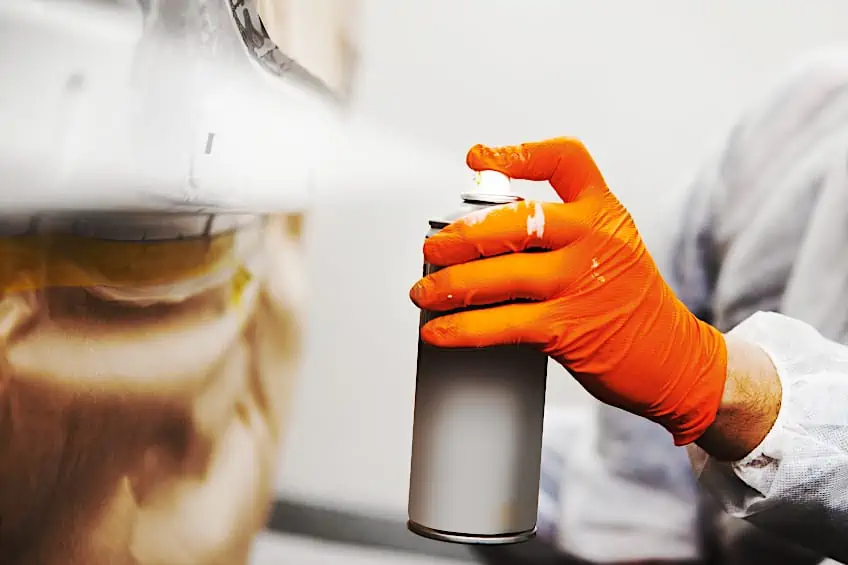
Apply More Layers of Spray Paint
Allow your first coat to properly dry and then continue to apply further coats as needed. Try to make sure that you don’t end up adding layers onto your vinyl too thickly as this will affect the adhesion and can also cause cracking. Remember that as you apply more layers, the color may change slightly. Be careful to make sure that you don’t add too many layers.

Let the Paint Cure
Once you are satisfied with the paint job on the surface of your vinyl, allow the paint to cure properly for a minimum of ten hours before using the object. Allowing the paint to properly cure is crucial if you want to prevent cracking, peeling, and lifting.
Painting vinyl is a simple way to bring new life to worn surfaces. It can save you money if you refurbish faded vinyl rather than replace it. Following our tutorial will allow you to give spray painting on vinyl a chance. Once you try it out you can easily refurbish all kinds of vinyl surfaces without breaking the bank.
How to Use Vinyl Spray Paint Safely
Spray paints can be dangerous if used incorrectly. The VOCs in spray paint can be hazardous to your health. Spray paints are also often combustible, and the pressurized can could injure someone if damaged. Below we have outlined a few general precautions to take while working with spray paint. Always be sure to read the manufacturer’s instructions before starting a project as some brands may have further instructions and precautions that are specific to your chosen product.
- Keep your spray paint can away from sources of ignition or extreme heat such as a stove, fire, or heater. This also includes prolonged exposure to sunlight.
- Do not puncture your spray paint can. Do not damage the integrity of your spray paint can in any way. This includes burning, denting, cutting, or disposing of used cans in a trash compactor.
- Avoid inhaling vapors from your spray paint by working outside or in a properly ventilated area. Alternatively, you can wear respiratory protection while you work. Keep children or pets away from you while you work.
- Avoid letting the vapors make contact with your eyes and skin. Wear gloves and goggles as an additional protective measure. Make sure you know the steps to follow if you do accidentally get spray paint in your eyes. This information can be found on the product.
- Do not paint wiring, lightbulbs, damaged cords, or other parts of a light fixture that get hot or conduct electricity.
- Do not paint surfaces that will be in direct contact with any open flame.
What to Consider When Buying Spray Paint for Vinyl
Now that you have an idea of what kinds of vinyl spray you may encounter, it is a good time to consider some other factors that may influence what brand or product you choose. Budget, consistency, color, and many other factors will come into play when you decide what vinyl paint is best suited for your needs. If you hope to buy the best spray paint for vinyl you must make sure that you are choosing according to your needs.
The Vinyl Surface You Want to Paint
You need to take time to consider what vinyl surface you will be using vinyl spray on. Are you painting vinyl fabric or upholstery? Is it a hard or rigid surface like the dashboard of a car, a fence around a property, or the surface of an old cooler box? How often is the object used? Will it be outdoors for prolonged periods? All of these things should be considered if you are hoping to choose the best spray paint for plastic.
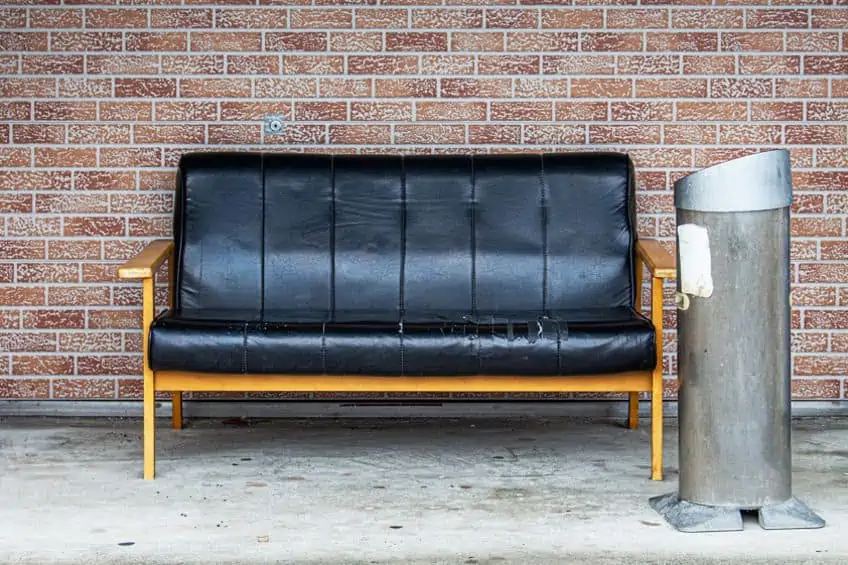
Your vinyl spray paint must be suitable for where it is used. If you are spraying something that is largely used outdoors, or will be used frequently it must be durable and waterproof. If you are painting vinyl fabric you must ensure the paint is sufficiently flexible or it will crack and peel over time.

Spray Paint Color and Finish
There is a wide range of vinyl spray paint colors that you will have to choose from and it may be quite overwhelming. Luckily there are a few things you should keep in mind that may help you narrow down your choices. Firstly, you will want to consider where you will have your piece situated once again. If you are spraying a car’s upholstery then you might want to rethink using white or beige colors as they can easily show dirt and other signs of use. On the other hand, you may like the modern look that white paint on vinyl can lend to upholstery or siding on a house.

Make sure that you choose vinyl spray paint colors that are practical, but also match your taste and style. Even if you do not mind initially using a color you do not really like, it will become a problem later down the line when it may clash with other objects in its surroundings. Pick a color that you like and that excites you.
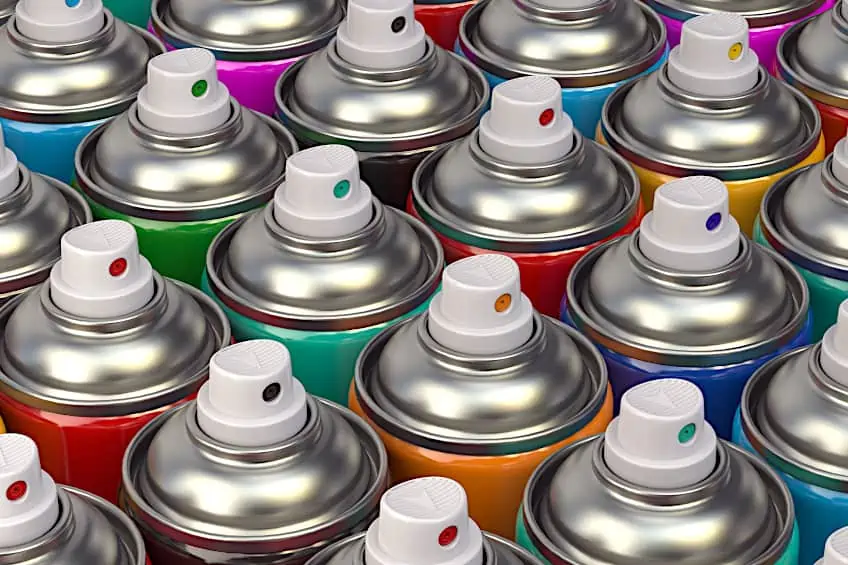
The third point to consider when choosing vinyl spray paint colors is that darker colors hide imperfections better, and have better coverage than softer, lighter colors. Better coverage means you will use less vinyl spray, but also spend less time when using paint on vinyl. If you are spraying correctly you will need to do multiple light layers rather than a few thicker even ones, as the latter can cause blotches and drips to appear on the surface. It also helps you gauge the vibrancy of your coatings and control the opacity you would like on your completed piece.

Vinyl spray paint is also available in different finishes. You may want a gloss look on your couch but a matte finish on a dashboard. Browse around and consider all the different finishes available for your project and make sure that they are practical. For example, matte vinyl spray on couch upholstery may wear down very quickly with use.

Your Available Budget
Certain colors and finishes may cost more than others when choosing paint for vinyl. Luckily regardless of what color or finish you choose, vinyl spray paint will always work out cheaper than buying a tub of vinyl paint, buying a replacement, or hiring the services of a professional to refurbish your vinyl. The price of a vinyl spray will also depend on the brand and size you choose. Higher quality brands will cost more, and they are well worth the extra investment.

If you are unsure about spending money on a premium brand, it is worthwhile remembering that you do not want to have remove fresh paint from a surface because you don’t like the results of a cheaper brand. Stripping off paint could really damage the surface of your vinyl. Rather, wait until you are ready to make a bigger investment and purchase the best spray paint for plastic, than risk having the spray ruin your vinyl surface, or not adhere properly, and make a big mess.
The Amount of Volatile Organic Compounds in the Spray Paint
When looking for spray paints you should try to avoid brands that have a lot of volatile organic compounds (VOCs). VOCs can be detrimental to your health if inhaled or if they make contact with your eyes. It is always best to wear a mask when working with spray paint. Alternatively, you can work outside or in a very well-ventilated room. Wear gloves and make sure that you avoid any contact between the vapors and your eyes.

The Best Surfaces to Apply Vinyl Paint To
While you can technically use vinyl spray paint on any vinyl surface and it will adhere, you probably shouldn’t just spray every surface you come across. For example, you may want to reconsider painting children’s toys or vinyl carpets. Aside from this, you must consider what kind of finish your vinyl spray paint has. If you have a matte finish, you should rather use it on an object that will not be handled much or in an area that does not get much foot traffic. These areas and objects would do better with a coating that has a smooth or gloss finish. As a general rule, avoid using matte finishes in high-traffic areas, on floors or ceilings, on sealant surfaces, or anywhere that has a lot of moisture such as a bathroom or kitchen.

How Do I Remove Paint From Vinyl?
Removing spray paint from vinyl can be very tricky and difficult to do. There are a few different ways you can try to remove vinyl spray paint from the surface of your vinyl, but it will depend on how old the paint is and what kind of paint has been used. If you find that there is paint somewhere on the vinyl where you do not want it, you must act quickly. The sooner you start removing the paint, the better your chances are at removing it. Whether it’s a stray drip of paint or a big glob, we have outlined some tried and tested ways to remove paint from vinyl below.
Tips for Removing Paint From Vinyl
- Regardless of what method you use to remove paint from vinyl, make sure to properly rinse the area with water once you are done.
- Use a nylon-bristled brush to scrub the vinyl surface. A nylon brush scrubs thoroughly enough without dulling the surface of the vinyl. Do not use something like iron wool to scrub the area as it will scratch your vinyl.
- Lighter colored vinyl will be harder to clean properly and darker paints will be more difficult to remove. Try to be patient while you clean, you do not want to rush the process. Rushing can cause you to scrub too hard or make an even bigger mess.
- If you use chemicals to clean paint off of your vinyl, make sure that you take the proper precautions according to the manufacturer of the chemical. This can mean anything from working in a ventilated area to wearing a respirator and gloves.
- Chemicals can work to thin dried paint but may cause it to smear, so make sure to use small circular motions while cleaning large areas. Be sure to not spread the paint around on your vinyl. Try using a different area of a cloth, or grab a fresh one before continuing.
How to Remove Paint From Vinyl
If the paint is still wet you can simply wipe it away and wash the area. If the paint is dried you may have to scrub a bit harder or use harsh chemicals to remove the paint. If scrubbing doesn’t work you can try to use thinners, isopropyl alcohol (hand sanitizer), or acetone to remove the dried spray paint from your vinyl surface. Another option is to try to use some graffiti remover. Alternatively, you could also physically remove paint by scratching or sanding it away if it has already dried.
Remember to consider your surface when attempting these methods, you may not want to risk scratching at your vinyl fabric or using any harsh chemicals on it. On the other hand, you may not hesitate to use thinners on your vinyl siding. Consider the risks that each of these spray paint removal methods may have on different surfaces before trying them out.
When you spray paint on vinyl you may feel as if you are being faced with a very challenging task. This doesn’t need to be the case! Choosing the correct product and following the proper procedure will make this refurbishment project a simple task for beginners and experienced crafters alike. There are so many ways vinyl is used which means there are just as many vinyl surfaces for you to try your hand at painting.
Frequently Asked Questions
What Happens if You Sand Vinyl?
Vinyl almost always has a textured or patterned surface. When you sand this surface, you will remove this texture as well as the finish on the vinyl, but it will help the paint to adhere more readily.
How Important Is It to Use Primer?
Primer helps spray paint adhere to the surface of vinyl more readily. It does this by providing a base color to apply paint to, but also by sealing surfaces. Lightly colored primers work better with lighter shades of spray paint.
What Primer Should I Use on Vinyl?
Bonding primer is ideal for use on vinyl as it is formulated to adhere to trickier surfaces, such as vinyl, with ease. Other primers can be used and you can even use no primer at all, but it definitely makes a difference and increases the longevity of your work.
What Are Some Ideas for Vinyl Surfaces to Spray Paint?
You could paint vinyl siding, vinyl floors or ceilings, vinyl upholstery, window frames, photo frames, and more. Anything that is made from vinyl can be spray painted using the tips, products, and tutorial found in this article.








